RetroLisa
------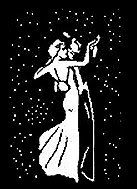 | The Great Depression | |
|
___________________________________________________________________________________________________________
|
|
|
RetroLisa
| _______________________________________________________________ | __ | _________________________________ | _______ | Losses
In retrospect, the 1920s appeared to be a very prosperous decade. Below the surface, however, the American economy was being weakened by many factors. When the 1929 stock market crash occurred, these factors caused the economy to crumble into dust.
Visit my 1929 Stock Market Crash page to read about it.
maybe it won't last?
The devastating effects of the crash became apparent almost immediately, but at first it looked like the bad times might not last. Stock prices actually rose during the early months of 1930, giving people false hope. It was not to be, however....prices resumed falling in May 1930.
_______________________________________________________________
the rich
Although the amount of money lost in the crash was high, the number of people who were directly affected was relatively small. The first individuals to feel the pinch were the wealthy businessmen and financiers who took a hit in the stock market. Some were driven to suicide, while others adopted a nonchalant, almost arrogant attitude.
business & industry
At first, businesses cut salaries, reduced production and laid off workers to keep afloat. Sadly, this was not enough. By the end of 1931, nearly 60,000 businesses had failed. Another 26,000 businesses failed the following year. Auto sales fell by half, causing Henry Ford to shut down his factories. Industrial output in 1933 was less than half of what it was in pre-crash 1929.
workers
When the economy began its downward spiral, employers responded by cutting salaries an average of 40 to 60 percent. This was followed by layoffs and business failures, resulting in rampant unemployment with no end in sight.
unemployment stats
- October 1929: 700,000
- November 1929: 1.5 million
- March 1930: 3.2 million
- Later in 1930: 7.5 million
- 1931: 8 million
- 1932: 12 million
- 1933: 25 percent of the work force
banks
Nearly 1,360 banks failed during the first year, and another 2,294 banks failed in 1931. People lost their life savings, and banks were not in a position to lend money to struggling farmers or businesses.
savings
With each bank failure, people lost their entire life savings when their uninsured deposits vanished. Between 1930 and 1933, nine million savings accounts were wiped out. The accounts that were kept in solvent banks were cleaned out when people lost their jobs and needed to use their savings to survive.
a vicious cycle
When people don't work, they don't buy. When banks can't lend money and people don't buy, industry shuts down. When industry shuts down and production slows, people are laid off. Things got worse and worse.
A Run On The Bank
| |
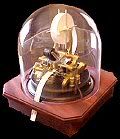
Universal Stock Ticker
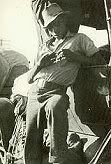
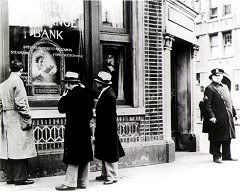
Thousands of banks closed during the Depression
|
_________________________________________________
|
|
|
RetroLisa
| ________________________________________________________________ | __ | ________________________________ | _______ | Despair
hunger
With no income, people simply couldn't buy food. Hunger was the most devastating result of all.
People fought each other for scraps of food in restaurant garbage cans. Men attacked trucks delivering food to hotels. In cities, thousands of people lined up at soup kitchens.
At an Appalachian mountain school, a girl who looked sick was told to go home and get something to eat. "I can't," she replied. "It's my sister's turn to eat."
In backwoods areas, people ate dandelions and blackberries, and hunted rabbits, squirrels, possums and birds.
living in squalor
People who managed to keep their homes often did without heat or light because they couldn't pay the bills. Landlords couldn't afford to maintain their buildings, leaving destitute people to cope with filthy tenements that were one step away from total collapse. Middle class families lost their homes to foreclosure and were forced to convert their tiny summer cottages into year-round residences.
homeless
If you were unable to pay the rent, you were evicted. Whole families were thrown out of their homes and their belongings were stacked outside on the sidewalk.
Children at play in the early 1930s moved their dolls around in a new game they called Eviction.
Homeless people slept in doorways, on park benches and under shrubbery, viaducts and bridges. They took advantage of abandoned properties by sleeping in old autos, broken down trolleys and large ovens and pipes in closed factory yards. If they managed to get a little money, they spent the night on urine-stained mattresses in lice-ridden, rat-infested flophouses for 10 to 15 cents a night.
They constructed makeshift shacks and shanties out of scrap wood, scrap metal, cardboard, orange crates and metal signs. On the outskirts of town, these groupings of shacks were known as shantytowns and hoovervilles.
The homeless foraged for food in garbage dumps, panhandled on the street, begged at homes, and made mulligan stews out of whatever they could find that was edible.
low morale
An attitude of resignation and defeat began to show itself everywhere. 20,000 people committed suicide in 1931. Even President Hoover had an attitude of defeat at the end of his term.
schools shut down
In 1933, many towns ran out of the funds necessary to keep their schools open. For 175,000 children, school didn't open at all that year. For millions more, the school term ended on January first. Overall, school terms were shortened in 25 percent of American cities and 5,000 schools closed completely. This was especially difficult for those youngsters who were hit hard by the poor economy and saw education as the road to a better life.
hobos & tramps
Hobos and tramps rode the rails to find, if not a better life, at least some temporary work. Visit my Everyday Life page to learn about hobos.
children fending for themselves
During the Depression, many teens couldn't afford the luxury of staying in school. A lack of funding also forced many schools to shut down. As a result, three million youngsters did not attend school in the early 1930s. For many of these kids, life at home was unbearable. With nothing to lose, thousands of these youngsters decided to take their chances out in the world by becoming teenage hobos. They usually traveled in groups, where they protected each other and stood up for each other. Some were girls who traveled with and dressed like boys. Visit my Everyday Life page to learn about teenage hobos.
loss of basic rights
Some areas banned welfare recipients from voting, and poll taxes prevented those without money from voting. Property and residency requirements prevented the homeless from voting and sometimes even from receiving aid.
Substandard Housing
Unemployment
Job Lines
Foreclosures
Teenagers Riding The Rails
| |
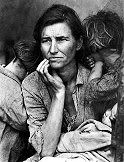
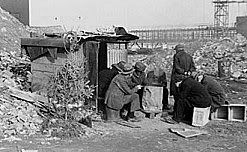

Homeless shelter
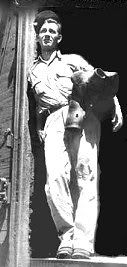
|
_________________________________________________
|
|
|
RetroLisa
| ___________________________________________________________________ | __ | _____________________________ | _______ | Hoover's Response
lack of action
President Hoover and other politicians believed that free enterprise, individual charity and hard work would bring us out of the Depression. They regarded direct federal assistance as an evil policy that would stifle the self-reliance Americans were famous for.
The government tended to ignore the problems of the Depression. In fact, some politicians arrogantly believed that hard times were good for us.
"Too much prosperity ruins the fiber of the people."
--Dwight Morrow
Hoover insisted that the Red Cross and other private charities take up the burden of helping the poor. The task was overwhelming, and became nearly impossible when federal funding was withheld.
Hoover slang
While President Hoover didn't cause the Depression, his inability or refusal to do anything about it caused him to be blamed for it just the same:
- Hoover blankets: old newspapers used for warmth while sleeping on park benches
- Hoover flags: the fabric of empty pockets turned inside-out
- Hoover hogs: jackrabbits caught for food
- Hoover wagons: old broken-down autos towed by mules
- Hoovervilles: groups of shacks and shanties on the outskirts of town
out of touch
Hoover was completely out of touch. He was unable to recognize the severity of the economic catastrophe and continued to insist that "prosperity is just around the corner." He also didn't seem to comprehend the steps people were taking just to survive. When hundreds of destitute people were selling apples on city streets, he wondered why "so many persons left their jobs for the more profitable one of selling apples."
too little, too late
Finally, President Hoover enacted some programs to aid the American people. Unfortunately, he continued to resist offering direct assistance, and his plans were a classic example of too little, too late.
Among Hoover's programs were dam building projects, loans to farmers for feed and seed, and the introduction of a one-year deadline for all foreign countries to repay their debts.
| |
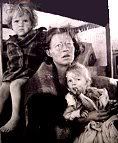
|
_________________________________________________
|
|
|
RetroLisa
| _______________________________________________________________ | __ | _________________________________ | _______ | Coping
charity
The Red Cross tried valiantly to help the poor, but they couldn't do much without the federal funds they needed. The money they managed to raise was quickly used up, and families had to be dropped from the rolls and turned away.
Mexican repatriation
Between 1931 and 1934, America used threats, propaganda and the offer of free transportation to send Mexican-Americans back to Mexico, thereby reducing the burden and opening up more jobs for native-born citizens.
apple sellers
The International Apple Shippers Association sold apples to the unemployed at a greatly reduced rate on credit. This resulted in city streets crowded with apple sellers....there were 6,000 in New York City alone. This remedy only worked for a short time, and by the end of 1931 the apple sellers were all gone.
bonus army
In 1932, World War I veterans camped at the White House, demanding an advance payment of a war bonus that wasn't scheduled to be dispensed until 1945. This group was known as the Bonus Army. The House of Representatives agreed to the payout, but the bill was defeated in the Senate. President Hoover used military force to chase the Bonus Army out of Washington.
self-help organizations
In some cities, self-help organizations formed barter systems. People who didn't have money could trade services for food and other necessities.
criminals
As usual, there were people who took it upon themselves to work outside the law. Gangsters and criminals never robbed poor people, and they often tore up mortgages when they robbed a bank. This made them heroes to the oppressed and poor.
rent parties
A rent party, or skiffle, was a dance party held in a private home or apartment. Admission to the party was a contribution that went towards paying the rent. The tradition began among black folks in Harlem, where it remained the most popular.
penny auctions
Farmers used threats and violence to prevent buyers from bidding more than a few cents on foreclosed farms. In this way, the farm and equipment could be bought back by the original owner for next to nothing, and his land was saved.
foreclosure moratoriums
Some states passed foreclosure moratorium laws, which put a hold on farm foreclosures until the economy improved.
soup kitchens
Large cities established soup kitchens and bread lines, and thousands of unemployed people waited in line every day for the simple meals they offered. Even Al Capone and his gang opened Chicago's first soup kitchen in 1931. For many people, the soup kitchen meal was the only food they would see that day. At its peak, New York City had 82 bread lines providing 85,000 meals a day. It was difficult for hard-working people to swallow their pride when hunger drove them to a soup kitchen.
morale-boosters
Movies, songs and humor provided an escape from the harsh realities of the Depression. Rumors of bankrupt financiers committing suicide prompted Eddie Cantor to add a new joke to his Broadway routine:
Hotel clerk to guest: "Do you want the room for sleeping or for jumping?"
When expensive nightclubs and dance halls were out of the question, young people paid weekly dues to join cellar clubs. Members gathered in tenement basements, where entertainment and recreation was provided by a radio, ping-pong table and piano.
looking for a better life
Foreclosed farmers, hobos and dust bowl refugees became migratory field hands. Many of them traveled from state to state, following the harvest. Others moved to the lush, fertile fields of California.
Soup Kitchens & Bread Lines
Iowa Calls Halt To Penny Auctions
The Bonus Army
Rent Parties
| |
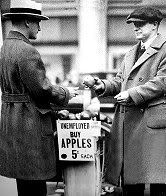
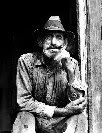

Al Capone's soup kitchen
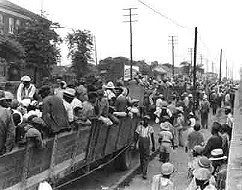
Black migrant workers prepare to travel to the next farm
|
_________________________________________________
|
|
|
RetroLisa
| ________________________________________________ | ___ | ______________________________________________ | ________ | The New Deal
When Franklin Delano Roosevelt became President in 1933, he pledged a new deal for the nation. During the first 100 days of his term, he passed a flurry of legislation and created agencies to get the ball rolling. Americans referred to his programs and their various acronyms as Roosevelt's Alphabet Soup.
1933 Emergency Banking Act
Roosevelt shut down the nation's banks for four days while he put together a plan to stabilize them. He held his first radio fireside chat to announce the reopening of the banks.
1933 Federal Emergency Relief Administration (FERA)
To combat the immediate results of the depression, Roosevelt gave $500 million to the state governments for emergency food and shelter.
1933-1934 Civil Works Administration (CWA)
The CWA provided four million construction and public works jobs during the winter of 1933-34. Despite the best efforts of First Lady Eleanor, only 19 percent of the workers were women.
1933 Federal Surplus Relief Corp
This agency purchased surplus animals and crops for distribution to the state governments.
1933-1942 Civilian Conservation Corps (CCC)
Also known as soil soldiers and Roosevelt's tree army, the members of this agency were hired to work on conservation projects like reforestation, soil reclamation, wildlife refuges, firebreaks and improvements to our national parks.
Rural Electrification Administration (REA)
This agency provided electricity for rural homes and farms.
Federal Housing Administration (FHA)
By constructing housing projects in the inner cities, the FHA created affordable housing for low-income families.
1934-1940s Department Of Interior Homesteads
This organization provided subsidized housing for homeowners who agreed to work the land as dairy and truck farmers.
1933 Federal Deposit Insurance Corp (FDIC)
The FDIC insured bank deposits against bank failures.
also:
National Youth Administration (NYA)
Public Health Service (PHS)
| |

President Franklin D. Roosevelt
The CCC: Roosevelt's Tree Army
Posters From The WPA
History Of Social Security
Roosevelt's Fireside Chats
Tennessee Valley Authority
Works Progress Administration
FSA Photographs
1933 Public Works Administration (PWA)
This agency provided thousands of construction jobs all across the country. PWA workers built swimming pools, highways, bridges, band shells, hospitals, schools, tunnels and dams to irrigate land and provide cheap electric power. In 1933, nearly every county in America had at least one PWA project.
1933-1934 National Recovery Act (NRA)
Using the eagle as its symbol, this agency controlled prices, wages, working hours and working conditions.
1935-1943 Works Progress Administration (WPA)
The WPA was the New Deal's most ambitious and far-reaching project. This agency provided thousands of public works jobs and established literacy and adult education programs. It also provided work for artists, writers, composers and musicians. Murals were painted on public buildings, symphonies and plays were written, and literary projects were undertaken.
1934 Indian Reorganization Act
This agency reassigned reservation land, organized tribes into self-governing bodies, and halted the forced assimilation of Indians into white culture.
Tennessee Valley Authority (TVA)
The TVA worked on improvements and dam-building projects to bring cheap electric power to the rural south.
1933-1935 Agricultural Adjustment Act
1935-1937 Resettlement Administration (RA)
1937-1944 Farm Security Administration (FSA)
These agencies were designed to assist farmers and the rural poor by moving them to more productive lands and providing them with loans. They also sent photographers and photojournalists into the field to document the American lifestyle during the Depression and early war years.
1935 Social Security
This program was designed to provide financial security to Americans in the event of death, disability or old age. The first benefits were scheduled to be dispensed in 1942.
|
__________________________________________
|
|
|
